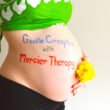I haven’t charted my cycles in about a year. Nine months of pregnancy + three months of post partum = not looking once at my thermometer. In fact, I’m not really even sure where it is….
A little back story first. I began charting my cycles with the Sympto-Thermal method years before getting pregnant with my daughter. I diligently took my temperature every morning and made notes about my cervical fluid throughout the day. I liked this method a lot and my husband and I enjoyed sharing the journey together. Once we got the positive pregnancy test we were looking for, I put my thermometer away in a bathroom drawer somewhere.
Fast forward nine months. My little bundle of joy came in a crazy whirlwind of events. Early postpartum, charting my fertility was the last thing on my mind.
When my baby started sleeping longer hours at night, it meant I wasn’t nursing as often and my long-dormant ovaries began waking from their slumber. I could tell my body was gearing up. I knew this day would come, and I knew I wanted to start a new method of charting that was particularly adapted to postpartum. For one thing, sleep deprivation doesn’t bode well for temping reliably at the same time every day. While we’re open to another pregnancy, I wanted to chart with a method I could actually commit to.
I got an instructor and began the Marquette Method of Natural Family Planning. For those who are wondering, “I thought Marquette was a university not a method of charting…” you would be half right. The Marquette Method developed at Marquette University and it uses the Clearblue Easy Fertility Monitor to chart. You pee on a little stick that you place in the Clearblue monitor. It tells you when your hormones have risen, indicating your fertile window, and when your peak has passed. It’s particularly popular with postpartum women because cycles can be a bit on the fritz during that time. So here’s the low down on what I do and don’t like about using this method, so far.
First,
The dislikes.
- It’s not the most ecological. I was always drawn to Natural Family Planning/fertility awareness methods because of it’s greenness. Just me, my app, and my thermometer. Arguably, you don’t even need those things. Some methods require just a piece of paper and your body. With the Marquette method, I use test sticks every day. So it feels a little wasteful with the packaging and plastic sticks. Granted, when in regular cycles, you only use 10 or so a month. But with postpartum I am using one test stick a day. Which leads to my next point…
- It costs. Because I’m using a stick a day, it costs me about $30 a month. When I was on the pill, I probably spent that much. But when I used Sympto-Thermal, I paid nada. The Clearblue monitor cost me $150 and I got it used. Never mind the fact that all forms of hormonal contraception and intrauterine devices are legally obliged to be covered by insurance, and my monitor and little test sticks are not—but we’ll save that conversation for another time.
- Traveling could be tricky. We have some travel plans coming up and I’m already thinking about bringing the monitor with me and making sure I have enough test sticks. Really this isn’t all that difficult, but you just want to bring extras in case your length of stay changes.

But now for the likes,
- It’s objective. It’s pretty straight forward. Low, High, Peak. It takes a lot of guesswork out for you and this busy, sleep deprived, exhausted mama can sing praises for that. I never had a problem temping before, and probably will go back to temping once I am regulated. But until then, I can say hallelujah.
- It’s techy. Some people look down on techy things with fertility charting. I, for one, love when tech and fertility charting I’m still waiting on my Wink and tempdrop! I love apps. Anything to make charting more modern, visual, and fun I can get down with. I admit, I’m a bit of a fertility nerd. But I do get a strange joy from opening my Clearblue monitor, putting the test in and watching that circle go round and round with the final outcome.
- It’s much more flexible than temping. I thought testing would be more work than temping but I’ve found the flexibility it allows somewhat of a relief. My test window is six hours! So I can get up, take care of the baby, put on a sweatshirt, and grab a cup of coffee all before testing. I don’t have to worry about temping at the same time or not moving before testing. And let’s be honest, when my alarm clock is a crying baby, my first thought is not “let me take my temperature.” This time won’t last for forever, but for now, I love the flexibility Marquette allows with testing.
All in all, I’m happy with this method and look forward to continuing it through postpartum and perhaps beyond. Ecological Breastfeeding is another great natural option for avoiding pregnancy adapted to changes in a mother’s body in the months following childbirth. Ultimately, I wasn’t following all of the protocols of that method, so I needed a better window into what was happening with my fertility. Marquette can feel a little sci-fi, but it’s another way to embrace and understand my natural fertility and I love that!








I had not heard before of the Marquette Method. And I appreciate the point that while artificial methods for birth control “are legally obliged to be covered by insurance,” NFP methods are not.
Love Marquette postpartum and in regular cycles! So easy!
Check out the Billings Ovulation Method.. This method is very practical and green. I believe it is the easiest method to use when someone is not getting a full 8 hours of sleep and it doesn’t require any additional strips or testing equipment. http://www.boma-usa.org BOMA-billings ovulation method.